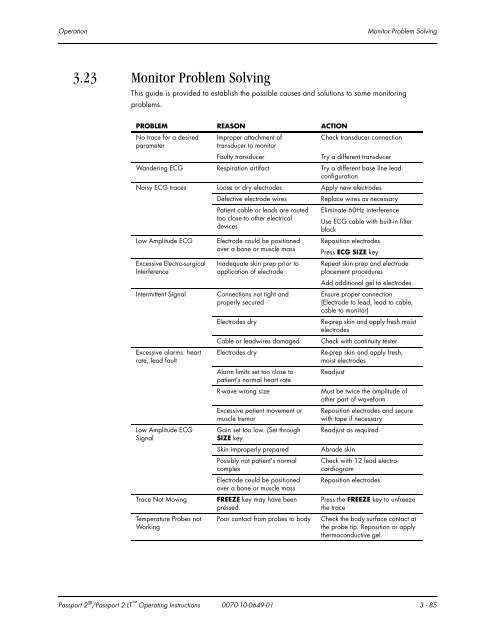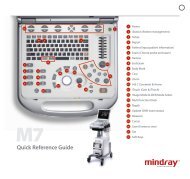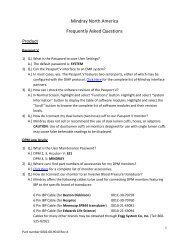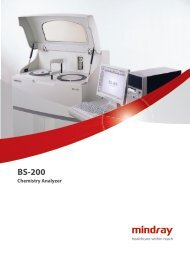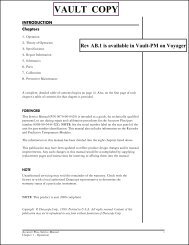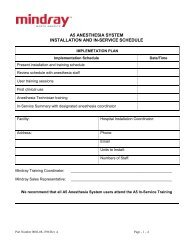Datascope Passport - Mindray
Datascope Passport - Mindray
Datascope Passport - Mindray
You also want an ePaper? Increase the reach of your titles
YUMPU automatically turns print PDFs into web optimized ePapers that Google loves.
Operation Monitor Problem Solving<br />
3.23 Monitor Problem Solving<br />
This guide is provided to establish the possible causes and solutions to some monitoring<br />
problems.<br />
PROBLEM REASON ACTION<br />
No trace for a desired<br />
parameter<br />
Improper attachment of<br />
transducer to monitor<br />
Check transducer connection<br />
Faulty transducer Try a different transducer<br />
Wandering ECG Respiration artifact Try a different base line lead<br />
configuration<br />
Noisy ECG traces Loose or dry electrodes Apply new electrodes<br />
Defective electrode wires Replace wires as necessary<br />
Patient cable or leads are routed Eliminate 60Hz interference<br />
too close to other electrical<br />
devices<br />
Use ECG cable with built-in filter<br />
block<br />
Low Amplitude ECG Electrode could be positioned Reposition electrodes<br />
over a bone or muscle mass<br />
Press ECG SIZE key<br />
Excessive Electro-surgical Inadequate skin prep prior to Repeat skin prep and electrode<br />
Interference<br />
application of electrode<br />
placement procedures<br />
Add additional gel to electrodes<br />
Intermittent Signal Connections not tight and<br />
Ensure proper connection<br />
properly secured<br />
(Electrode to lead, lead to cable,<br />
cable to monitor)<br />
Electrodes dry Re-prep skin and apply fresh moist<br />
electrodes<br />
Cable or leadwires damaged Check with continuity tester<br />
Excessive alarms: heart Electrodes dry Re-prep skin and apply fresh,<br />
rate, lead fault<br />
moist electrodes<br />
Alarm limits set too close to<br />
patient's normal heart rate<br />
Readjust<br />
Low Amplitude ECG<br />
Signal<br />
R-wave wrong size Must be twice the amplitude of<br />
other part of waveform<br />
Excessive patient movement or<br />
muscle tremor<br />
Gain set too low. (Set through<br />
SIZE key.<br />
Reposition electrodes and secure<br />
with tape if necessary<br />
Readjust as required<br />
Skin improperly prepared Abrade skin<br />
Possibly not patient's normal<br />
complex<br />
Electrode could be positioned<br />
over a bone or muscle mass<br />
Trace Not Moving FREEZE key may have been<br />
pressed.<br />
Temperature Probes not<br />
Working<br />
Check with 12 lead electrocardiogram<br />
Reposition electrodes<br />
Press the FREEZE key to unfreeze<br />
the trace<br />
Poor contact from probes to body Check the body surface contact at<br />
the probe tip. Reposition or apply<br />
thermoconductive gel.<br />
<strong>Passport</strong> 2 ® /<strong>Passport</strong> 2 LT Operating Instructions 0070-10-0649-01 3 - 85


